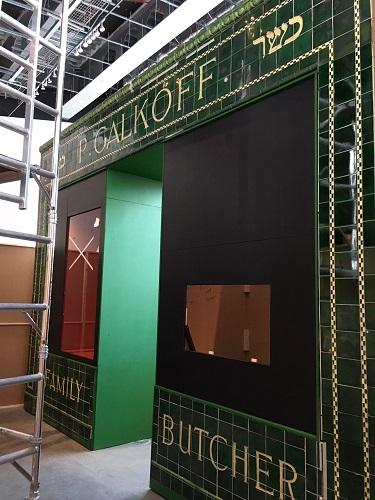At the Cutting Edge, with Edge Conservation

Today we have a guest blog from Anna Dembicka, who has worked on the Galkoff's and Secret Life of Pembroke Place project as an ICON Ceramics Intern. Anna's detailed work on the tiles with the Edge Conservation team has brought them back to beautiful condition for display in the People's Republic gallery at the Museum of Liverpool.
 Galkoff shop before tile removal
Galkoff shop before tile removal
'There are few people in Liverpool who don’t immediately recognize the green façade of the tiled Galkoff Kosher butcher’s shop. Having travelled past it on my way to university every day, I often thought about what its history and its future fate might be. But it never crossed my mind then that a few years later I would have the privilege of helping to restore it to its former glory and re-display it at the Museum of Liverpool.
Early stages
To start with, Elaine Tierney and Steven Edwards, under the supervision of conservator Lynne Edge ACR at Edge Conservation Services, very carefully and painstakingly removed the tiles from the building, working in less than ideal conditions in freezing weather in December! This process was far from straightforward as many of the tiles were bonded so strongly onto the walls that they had to be removed with layers of cement, metal mesh and on occasion even bricks attached to their backs! Once the tiles had been transported to Edge Conservation workshop, work on careful reduction of backing began. It was fascinating to see the amount of specialist skill required to do this task, keeping any damage to tiles to absolute minimum. A band saw, tile cutter and a couple of angle grinders were used and I got the chance to try it for myself under the careful eye of Elaine and Steve.

Me getting a taste of cement removal!
The most exciting part for me was…
Once the backing was reduced (not completely removed to avoid damage to tiles), we were able to start the cleaning process. We used techniques such as steam cleaning which achieved some amazing results. It felt like the shop front was finally getting the attention it deserved!  Tile recorded as 'Aa3' before and after cleaning
Tile recorded as 'Aa3' before and after cleaning
Later in the process it was equally exciting to see the tiles come together on large panels of a strong lightweight material called 'Cellite', making replica missing fragments, and retouching them. After grouting between the tiles, it really started to feel like the project was coming together and the results of months of hard work were clearly visible.
Some of the most interesting things for me were…
It was really interesting to see the evidence of how the tile façade had been looked after in the past. We discovered that the yellow lettering showed signs of scratches left by scrubbing- marks from the days when the owners took pride in the appearance of the shop and wanted it to look sparkling clean. We also realized that the people who fitted the tiles in the 1930s may have made a mistake when positioning the dot after ‘P’ and after ‘Galkoff’, placing the tile upside down! To keep true to the original, we had to copy their mistake on our mounts.
The most scary and challenging part was…

Tiles after installation in the Museum of Liverpool
Retouching has been the scariest and most challenging stage for me. Even though the concept of the project was not full restoration (instead we wanted the repairs to be visible when looking more closely), achieving a good background colour was important (and tricky)! Its been brilliant that the Heritage Lottery Fund have supported this important project. I am now delighted that this exhibition is open to the public and hope that visitors enjoy seeing the display and learning about the history of the Galkoff’s and Pembroke Place as much as I did!'
